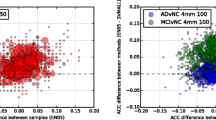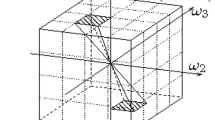Abstract
Multivariate statistical discrimination methods are suitable not only for classification but also for characterization of differences between a reference group of patterns and the population under investigation. In the last years, statistical methods have been proposed to classify and analyse morphological and anatomical structures of medical images. Most of these techniques work in high-dimensional spaces of particular features such as shapes or statistical parametric maps and have overcome the difficulty of dealing with the inherent high dimensionality of medical images by analysing segmented structures individually or performing hypothesis tests on each feature separately. In this paper, we present a general multivariate linear framework that addresses the small sample size problem in medical images. The goal is to identify and analyse the most discriminating hyper-plane separating two populations using all the intensity features simultaneously rather than segmented versions of the data separately or feature-by-feature. To demonstrate the performance of the multivariate linear framework we carry out experimental results on artificially generated data set and on a real medical data composed of magnetic resonance images (MRI) of subjects suffering from Alzheimer’s disease (AD) compared to an elderly healthy control group. To our knowledge this is the first multivariate statistical analysis of the human brain in AD that uses the whole features (texture + shapes) simultaneously rather than segmented version of the images. The conceptual and mathematical simplicity of the approach involves the same operations irrespective of the complexity of the experiment or nature of the spatially normalized data, giving multivariate results that are plausible and easy to interpret by the clinicians.
Similar content being viewed by others
References
Ashburner, J., Friston, K.J.: Voxel-based morphometry—the methods. NeuroImage 11, 805–821 (2000)
Bhattacharyya, A.: On a measure of divergence between two statistical populations defined by their probability distributions. Bull. Calcutta Math. Soc. 35, 99–110 (1943)
Busatto, G.F., Garrido, G.E.J., Almeida, O.P., Castro, C.C., Camargo, C.H.P., Cid, C.G., Buchpiguel, C.A., Furuie, S., Bottino, C.M.: A voxel-based morphometry study of temporal lobe gray matter reductions in Alzheimer’s disease. Neurobiol. Aging 24, 221–231 (2003)
Chetelat, G., Baron, J.C.: Early diagnosis of Alzheimer’s disease: contribution of structural neuroimaging. NeuroImage 18(2), 525–541 (2003)
Chen, L., Liao, H., Ko, M., Lin, J., Yu, G.: A new LDA-based face recognition system which can solve the small sample size problem. Pattern Recognit. 33(10), 1713–1726 (2000)
Chua, S.E., Wright, I.C., Poline, J.B., Liddle, P.F., Murray, R.M., Frackowiak, R.S., Friston, K.J., McGuire, P.K.: Grey matter correlates of syndromes in schizophrenia. A semi-automated analysis of structural magnetic resonance images. Br. J. Psychiatry 170, 406–410 (1997)
Duda, R.O., Hart, P.E., Stork, D.G.: Pattern Classification, 2nd edn. Wiley, New York (2001)
Folstein, M.F., Folstein, S.E., McHugh, P.R.: Mini-Mental state: a practical method for grading the cognitive state of patients for the clinician. J. Psychiat. Res. 12, 189–198 (1975)
Friston, K.J., Ashburner, J.: Generative and recognition models for neuroanatomy. NeuroImage 23, 21–24 (2004)
Friston, K.J., Holmes, A.P., Worsley, K.J., Poline, J.P., Frith, C.D., Frackowiak, R.S.J.: Statistical parametric maps in functional imaging: a general linear approach. Hum. Brain Mapp. 2, 189–210 (1995)
Fukunaga, K.: Introduction to Statistical Pattern Recognition, 2nd edn. Academic Press, Boston (1990)
Golland, P., et al.: Deformation analysis for shape based classification. In: Proc. IPMI’01. Lecture Notes in Computer Science, vol. 2082, pp. 517–530. Springer, Berlin (2001)
Golland, P., Grimson, W., Kikinis, R.: Statistical shape analysis using fixed topology skeletons: corpus callosum study. In: Proc. IPMI’99. Lecture Notes in Computer Science, vol. 1613, pp. 382–387. Springer, Berlin (1999)
Golland, P., Grimson, W., Shenton, M., Kikinis, R.: Detection and analysis of statistical differences in anatomical shape. Med. Image Anal. 9, 69–86 (2005)
Good, C.D., Johnsrued, I.S., Ashburner, J., Henson, R.N., Friston, K.J., Frackowiak, R.S.: A voxel-based morphometric study of aging in 465 normal adult human brains. NeuroImage 14, 21–36 (2001)
Grossman, M., McMillan, C., Moore, P., Ding, L., Glosser, G., Work, M., Gee, J.: What’s in a name: voxel-based morphometric analyses of MRI and naming difficulty in Alzheimer’s disease, frontotemporal dementia and corticobasal degeneration. Brain 127, 628–649 (2004)
Lao, Z., Shen, D., Xue, Z., Karacali, B., Resnick, S., Davatzikos, C.: Morphological classification of brains via high-dimensional shape transformations and machine learning methods. NeuroImage 21, 46–57 (2004)
Mazziotta, J.C., Toga, A.W., Evans, A., Fox, P., Lancaster, J.: A probabilistic atlas of the human brain: theory and rationale for its development. NeuroImage 2, 89–101 (1995)
Pettey, D.J., Gee, J.C.: Sexual dimorphism in the corpus callosum: a characterization of local size variations and a classification driven approach to morphometry. NeuroImage 17, 1504–1511 (2002)
Talairach, J., Tornoux, P.: Co-Planar Stereotaxic Atlas of the Human Brain. Thieme Medical Publishers, New York (1998)
Thomaz, C.E., Boardman, J.P., Counsell, S., Hill, D.L.G., Hajnal, J.V., Edwards, A.D., Rutherford, M.A., Gillies, D.F., Rueckert, D.: A multivariate statistical analysis of the developing human brain in preterm infants. Image Vis. Comput. 25(6), 981–994 (2007)
Thomaz, C.E., Kitani, E.C., Gillies, D.F.: A maximum uncertainty LDA-based approach for limited sample size problems—with application to face recognition. J. Br. Comput. Soc. 12(2), 7–18 (2006)
Thomaz, C.E., Gillies, D.F., Feitosa, R.Q.: A new covariance estimate for Bayesian classifiers in biometric recognition. IEEE Trans. Circuits Syst. Video Technol. 14(2), 214–223 (2004)
Thompson, P.M., Moussai, J., Zohoori, S., Goldkorn, A., Khan, A., Mega, M.S., Small, G., Cummings, J., Toga, A.W.: Cortical variability and asymmetry in normal aging and Alzheimer’s disease. Cerebr. Cortex 8, 492–509 (1998)
Vapnik, V.N.: Statistical Learning Theory. Wiley, New York (1998)
Wilkie, M., Kaufmann, C., Grabner, A., Putz, B., Wetter, T.C., Auer, D.P.: Gray matter changes and correlates of disease severity in schizophrenia: a statistical parametric mapping study. NeuroImage 13, 814–824 (2001)
Wright, I.C., Ellison, Z.R., Sharma, T., Friston, K.J., Murray, R., McGuire, P.K.: Mapping of gray matter changes in schizophrenia. Schizophr. Res. 35, 1–14 (1999)
Yang, J., Yang, J.: Why can LDA be performed in PCA transformed space? Pattern Recognit. 36, 563–566 (2003)
Yu, H., Yang, J.: A direct LDA algorithm for high dimensional data—with application to face recognition. Pattern Recognit. 34, 2067–2070 (2001)
Author information
Authors and Affiliations
Corresponding author
Rights and permissions
About this article
Cite this article
Thomaz, C.E., Duran, F.L.S., Busatto, G.F. et al. Multivariate Statistical Differences of MRI Samples of the Human Brain. J Math Imaging Vis 29, 95–106 (2007). https://doi.org/10.1007/s10851-007-0033-6
Received:
Accepted:
Published:
Issue Date:
DOI: https://doi.org/10.1007/s10851-007-0033-6




